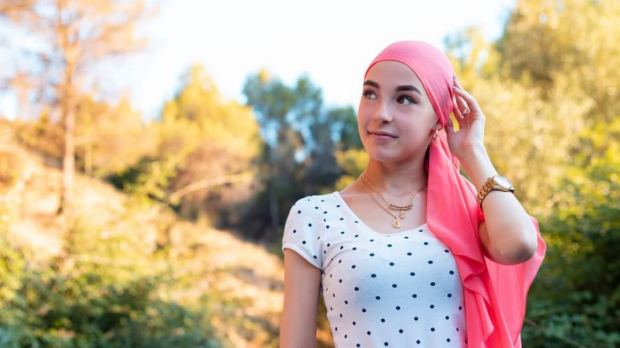It’s a known fact that when a woman changes her haircut or color, something may be about to change in her life, and if you don’t notice … there’s a good chance that it will be you!
If fuchsia, candy pink, or shatush hair speak of a desire for novelty, rebellion, or pages about to be turned, our hair is also capable of telling silent stories even when it’s not there.
This is the story of Aurora, the “scarf woman.” A non-Hodgkin’s lymphoma in her uterus forced her in 2014, at the age of 41, to undergo a hysterectomy, after refusing to give up in the face of an initial diagnosis of inoperability. She told the Ansa news service:
I had five biopsies but it wasn’t possible to figure out what kind of tumor it was. Then on March 26 I had hysteroannessiectomy surgery, which consists in the removal of the uterus, fallopian tubes and ovaries. The histological examination showed that it was a non-Hodgkin’s large B-cell lymphoma, which responds well to chemotherapy. The hematologist warned me that my hair would fall out and I replied that for me it was more important to win this battle, because my hair would grow back.
Discovering that we’re stronger than we think
She underwent eight rounds of chemotherapy, one two-day session every 14 days. She experienced total hair loss. She told Ansa:
It was devastating but I was always supported by my husband, and the confidence I saw in the doctors gave me strength. This path led me to discover parts of myself that even I didn’t know I had: I emanated tranquility, even though I wasn’t tranquil. I seemed strong and brave, even though in reality I was enormously afraid.
No one gives too much weight to losing hair in such a situation: what’s urgent and important is to beat the monster.
Yet, I think that in a situation that’s already that difficult, looking in the mirror and having to abandon even that part of you that still made you feel “yourself” is a burden that adds to the rest with the weight of a boulder. You fight, of course, but it’s harder to do it when the disease takes away everything, even what’s so unnecessary, a superficial aspect, but one that’s important for you to be able to say, “I’m still here, and I’m still me, despite everything!”
The “scarf woman”
Aurora refused to give in to it: that tumor would not take away her femininity.
She opted not to use a wig. “I didn’t have to hide in the face of the disease, and it didn’t matter if people looked at me,” she explains. However, she always wore new colorful scarves, tied around her head in different ways to create “hairstyles.”
Today, Aurora has defeated the disease, but has not stopped creating with her beloved scarves: she joined the association of volunteers, who attended her cancer ward while she was there, to support other women in the same situation. As she shares in her interview with Ansa:
I try to explain to chemotherapy patients how important it is not to neglect taking care of your beauty and never to lose hope. Cancer leaves its marks on your body, changing the vision you have of yourself. But my eyes still shine when I see my scar, and when I talk about the disease today, I do so with a smile on my face.
Helping to discover rather than just cover up
It’s not just about “covering up” our bald head or the signs of cancer, but perhaps more about “discovering” a new us, even in the face of illness; discovering a strength we didn’t think we had.
It’s funny how a single syllable or piece of cloth can move us from a perspective of fear to one of hope.
What’s more, every warrior has a battle helmet.
If it’s colorful and made of silk, even better!



